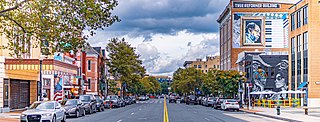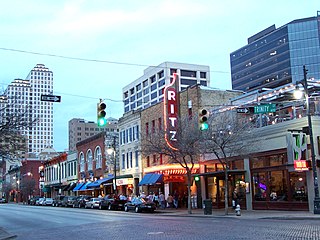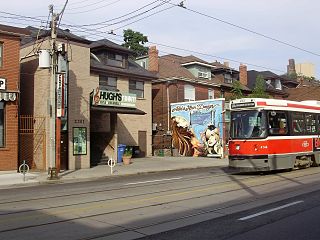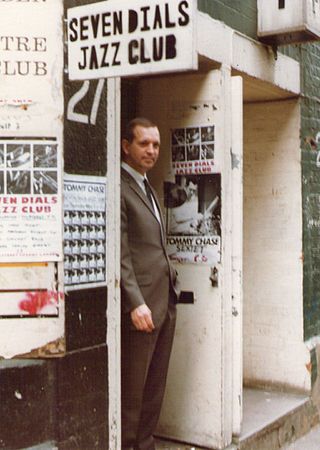Electric blues is blues music distinguished by the use of electric amplification for musical instruments. The guitar was the first instrument to be popularly amplified and used by early pioneers T-Bone Walker in the late 1930s and John Lee Hooker and Muddy Waters in the 1940s. Their styles developed into West Coast blues, Detroit blues, and post-World War II Chicago blues, which differed from earlier, predominantly acoustic-style blues. By the early 1950s, Little Walter was a featured soloist on blues harmonica using a small hand-held microphone fed into a guitar amplifier. Although it took a little longer, the electric bass guitar gradually replaced the stand-up bass by the early 1960s. Electric organs and especially keyboards later became widely used in electric blues.

Washington, D.C., has been home to many prominent musicians and is particularly known for the musical genres of Jazz, Rhythm & Blues, bluegrass, punk rock and its locally-developed descendants hardcore and emo, and a local funk genre called go-go. The first major musical figure from District of Columbia was John Philip Sousa, a military brass band composer. Later figures include jazz musicians, such as Duke Ellington, Charlie Rouse, Buck Hill, Ron Holloway, Davey Yarborough, Michael A. Thomas, Butch Warren, and DeAndrey Howard; soul musicians, including Billy Stewart, The Unifics, The Moments, Ray, Goodman & Brown, Van McCoy, The Presidents, The Choice Four, Vernon Burch, guitarist Charles Pitts, and Sir Joe Quarterman & Free Soul.
Massachusetts is a U.S. state in New England. The music of Massachusetts has developed actively since it was first colonized by Britain. The city of Boston is an especially large part of the state's present music scene, which includes several genres of rock, as well as classical, folk, and hip hop music.
The Music of Nebraska has included a variety of country, jazz, blues, ragtime, rock, and alternative rock musicians. Though many cities and towns across the state have active musical scenes, artists from Omaha and Lincoln have a particularly important musical legacy.
The U.S. state of New Jersey is located in the Northeastern United States and is part of the Mid-Atlantic region.
Virginia's musical contribution to American culture has been diverse, and includes Piedmont blues, jazz, folk, brass, hip-hop, and rock and roll bands, as well as the founding origins of country music in the Bristol sessions by Appalachian Virginians.

Austin's official motto is the "Live Music Capital of the World" due to the high volume of live music venues in the city. Austin is known internationally for the South by Southwest (SXSW) and the Austin City Limits (ACL) Music Festivals which feature eclectic international lineups. The greatest concentrations of music venues in Austin are around 6th Street, Central East Austin, the Red River Cultural District, the Warehouse District, the University of Texas, South Congress, and South Lamar.

South Carolina is one of the Southern United States and has produced a number of renowned performers of jazz, rock, blues, R&B, country, bluegrass and other popular styles.

Club Passim is an American folk music club in the Harvard Square area of Cambridge, Massachusetts. It was opened by Joyce Kalina and Paula Kelley in 1958, when it was known as Club 47, and changed its name to simply Passim in 1969. It adopted the present name in 1994; a combination of the earlier two names. In 1994 the venue also became a non-profit.

A piano bar consists of a piano or electronic keyboard played by a professional musician. Piano bars can be located in a cocktail lounge, bar, hotel lobby, office building lobby, restaurant, or on a cruise ship. Usually the pianist receives a small salary plus tips in a jar or basket on or near the piano, especially from patrons requesting a song traditionally written on a beverage napkin. Some piano bars feature a baby grand or grand piano surrounded by stools for patrons. Others have a bar surrounding the piano or keyboard.
The history of blues in New Zealand dates from the 1960s. The earliest blues influences on New Zealand musicians were indirect – not from the United States but from white British blues musicians: first the R&B styles of Fleetwood Mac, Eric Clapton, The Animals and The Rolling Stones, and later the blues-tinged rock of groups such as Led Zeppelin. The first American blues artist to make a big impact in New Zealand was Stevie Ray Vaughan in the early 1980s. Other blues-related genres such as soul and gospel almost completely by-passed New Zealand audiences, except for a handful of hits from cross-over artists such as Ray Charles.
Mountain Park, located on Mount Tom in Holyoke, Massachusetts, was originally built as a trolley park by the Holyoke Street Railway Company. Trolley parks were built just outside populated areas to encourage trolley usage on weekends. The Holyoke Street Railway company created two attractions, Mountain Park toward the base of Mount Tom, and a large house on the summit of the mountain.
Signature Sounds Recordings is an independent record label specializing in Americana and modern folk music. Jim Olsen and Mark Thayer founded the label in 1995 to promote acoustic musicians who were playing in Northampton, Massachusetts.
Dutch jazz refers to the jazz music of the Netherlands. The Dutch traditionally have a vibrant jazz scene as shown by the North Sea Jazz Festival as well as other venues.

Hugh's Room is a live music venue in Toronto, Ontario. Formerly on Dundas Street West until 2020, as of July 2023 it has relocated to Broadview Avenue in the city's East Chinatown neighbourhood.

The Seven Dials Jazz Club opened its doors in 1980 as a venue for live music in Covent Garden, London. It hosted a range of artists and styles of jazz and began to attract a regular audience. Starting in 1983, a series of saxophone festivals was held on the premises each year.
Amazingrace Coffeehouse was an influential counterculture music and performance venue in Evanston, Illinois, during the 1970s. Run by a collective called the Amazingrace Family, it was known for its welcoming atmosphere, eclectic menu, excellent sound system, and respectful audiences. Amazingrace was the top music club in the Chicago Reader poll 1973-1975, plus Number 3 in the 1975 wrap-up of "Who's Who in Chicago's Alternative Culture". Performers from a wide variety of genres played at Amazingrace from its beginning on the campus of Northwestern University until its final incarnation at The Main on Chicago Avenue in Evanston.
Sand Mountain Coffee House was a venue and home to Houston folk musicians from 1965 to 1977. Guy Clark, Townes Van Zandt, Jerry Jeff Walker, and Don Sanders were notable installations who wrote, performed, and sometimes lived at the coffee house.

Gilly's was a 250-seat music venue in Dayton, Ohio, mainly hosting jazz and blues music, which opened in July 1972 and closed on New Years' morning in January 2018.









